|
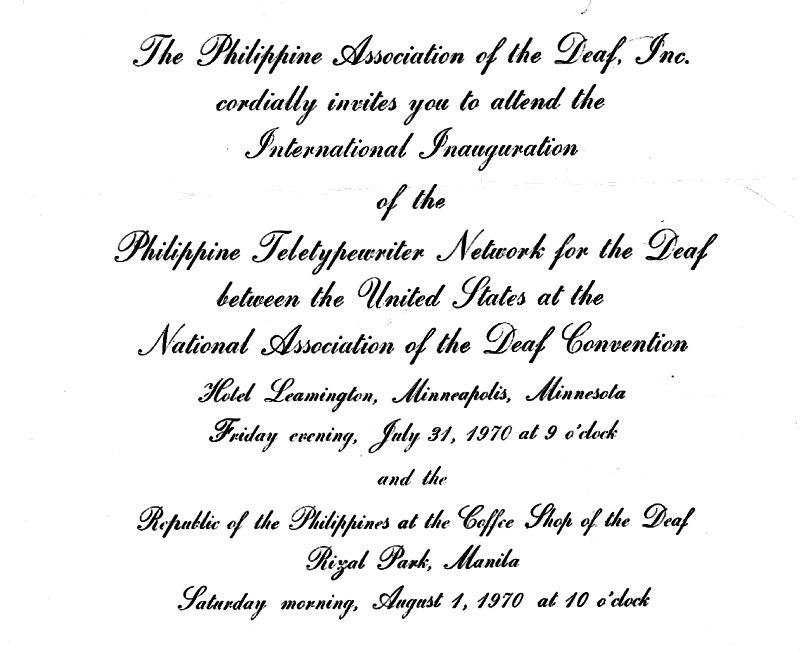
(Invitation
from the Paul and Sally Taylor Collection at
SMECC.)
Philippines Association Gets Assistance In New TTY System Applied Communications
Corporation of Menlo Park, California, donated one of the two Phonetypes which enabled the Philippine Association of the Deaf to begin its TTY system. The
Oral Deaf Adults Section of the Alexander Graham Bell Association for the Deaf,
Inc., paid the shipping charges on the Phonetypes.
|
-------------------
DOCUMENTATION OF THIS HISTORIC EVENT BY: CARL ARGILA
IN THE PHILIPPINES.
(This is a portion of an article form the Deaf American
- December 1970.)
In addition to the manual communication class I found myself very much involved in a project which I never would have imagined myself wrapped up in.
I noticed how difficult it was for the Philippine Association of the Deaf's
headquarters in San Juan, Rizal (a suburb of Manila), to communicate with their coffee shop in Rizal Park. In fact. the only communication possible was via a
messenger who would take public transportation (converted jeeps. called jeepneys") between these two locations. Being an engineer by profession I thought of the possibility of telephone communication. At first it seemed like a pretty wild idea. The only other deaf community to have telephone communication was in the United States, and the teletypewriter
network for the deaf was just starting there. How could I get the necessary
equipment? And, even if I did, there was no telephone at the Rizal Park Coffee Shop; the usual waiting period for telephone service in Manila is about one year. I only had about two more months
remaining in the Philippines.
Disregarding all of these things, I went ahead and sent off a letter to my good friend and colleague, Edgar Bloom, Jr .. asking for help. In the meantime I spent every spare minute trying to get
teletypewriter machines and telephone service at the Coffee Shop. The Philippine Long Distance Telephone Company was quite interested in the whole thing; however. they could not donate any teletypewriter equipment. They did promise, though. to give us immediate telephone service IF we could locate teletypewriters. I scrounged around the province of Rizal (in which Manila is located) looking for teletypewriters but without luck; most people had never heard of anything like a teletypewriter. Finally, I approached
Robert Scully of RCA Global Communications in Makati, Rizal. RCA had machines available which could be donated to the
deaf, but this would have to be cleared through their New York office; that would take many weeks.
Just when I thought all hope was lost, Mr. Scully remembered that there were two machines available immediately. They had been damaged during the last earthquake and were "written off"; however, they had been restored and were in like-new condition. They could be donated to the deaf
immediately. Now we were in business. Machines were installed; a special booth had to be built at the Coffee Shop, which is out-of-doors, to protect the valuable equipment from the elements. The
telephone was installed. And I was promoting the virtues of telephone communication for the deaf to an incredulous group of deaf persons. We realized that, by
coincidence, the National Association of the Deaf would be having their biennial
convention shortly. Wouldn't it be wonderful, I thought, to inaugurate our "Philippine Teletypewriter Network for the Deaf" by exchanging telephone greetings, for the first time in history, across the Pacific with the National Association of the Deaf. We still had one problem, though, we lacked the most vital link in our system. We had no Phonetype units, the device which enables the teletypewriter to be connected to the telephone.
Meanwhile, back in the states, Mr. Bloom and another colleague of ours, John
I. Sheetz, were trying to figure out how to send two Phone type units halfway 'round the world, and do it in time to have an "international inauguration" with the NAD convention in Minneapolis. Since no groups could be found who would
donate the equipment to us, I agreed to have the two Phone type units sent to me on consignment. They were shipped by air freight about two weeks before the scheduled inauguration. That seemed like ample time to get everything checked out for the inauguration. I knew the day they were shipped and waited anxiously for any word of their arrival. Days went by. Then one week. Ten days. Eleven days. I was desperate. I went to Manila International Airport to search for the
missing Phonetype units; the plane couldn't have been that slow!
The units were neither lost nor purloined- merely an overzealous clerk had decided that if we waited for the units, then the company could collect a larger storage fee, which accrued daily. After venting my spleen briefly (my repertoire of Tagalog curse words being too limited for a prolonged barrage) I tried to run off with the Phonetype units. But not so fast! It seems that. since they were not donated to the Philippine Association of the Deaf, but rather sent on consignment to me they were liable for import duty. How much? I asked. (Surely it couldn't be more than a few pesos, which I would gladly pay to have the equipment.) About 80% of their value, I was told. I went home thoroughly dejected; this seemed like the end of the line (literally). I
explained the situation to Mr. West. He felt, that since the Philippine Association of the Deaf was a non-profit corporation the units could possibly be released without duty. It took him the remaining two days before the inauguration, playing "musical offices" in the government
buildings, but, the afternoon before the inauguration, Mr. West walked into the Coffee Shop carrying two large boxes. The units were quickly installed and the two
stations checked with each other. After some simple adjustments we were ready for the historic day.
The morning of August 1, 1970, "dawned bright and clear." There was moisture on the ground; it had rained the night before. The international inauguration was scheduled to start at 10:00 a.m. It would be 9:00 p.m. July 31, at the Hotel Leamington in Minneapolis where the National Association of the Deaf would receive our call. Mrs. Fernando Lopez, wife of the vice president of the Republic of the Philippines, would be the guest of honor and would exchange the first
greetings with Robert O. Lankenau, president of the NAD. I arrived at the Coffee Shop early to be sure that everything would be ready for the ceremony. Doughnuts and coffee were being laid out for the expected one hundred guests. Painters were just finishing the trim and posts of the Coffee Shop's new overhanging roof. This was supposed to have been finished several days ago, but this was the week they got paid, and Filipino custom deems that the last few days be more of a holiday than a work day.
As the guests began to arrive I checked and rechecked the equipment. This had no positive value, except perhaps to make me feel better, and it did make the time move faster. Shortly before 10:00 a.m. a black Lincoln Continental drove up. Out stepped Mrs. Lopez with her personal secretary. After introductions and a few photographs I walked into the booth to make the historic call. As quickly as you might dial cross-country, the Filipino
operator connected our phone, via satellite, to the Hotel Leamington in Minneapolis, Minnesota. The switchboard had been alerted for the call and connected us 1.0 the banquet room where the stateside
ceremony would be held. I heard the phone removed from the cradle in the banquet room and quickly put my phone into the Phonetype unit. The teletypewriter was whirring away, but nothing happened! I waited, still nothing. I picked up ' the telephone handset and listened, sure enough there were "beeps" but nothing was printing. I replaced the handset into the Phonetype unit and started typing:
CARL ARGILA HERE IN THE
PHILIPPINES. DO YOU READ ME? GA.
I waited anxiously. Nothing. Then, the teletypewriter started groaning and suddenly came to life. The letters and words started to pour forth:
WE READ YOU LOUD AND CLEAR.
THIS IS ROBERT O. LANKENAU, PRESIDENT OF THE NATIONAL ASSOCIATION OF THE DEAF
. . .
What. a thrill! We all cheered. We had made history. For the first time, the deaf had communicated via telephone halfway around the world. Everything was all set now for Mrs. Lopez to cut the ribbon inaugurating the Philippine Teletypewriter Network for the Deaf and to exchange greetings with Mr. Lankenau. As she walked up to the booth she passed one of the freshly painted posts.
Fortunately she did not stain her dress. How embarrassing that would have been!
All of this, of course, was very impressive, but for me the climax came when a slight, gray-haired old woman, bent with age, lifted the hem of her beautiful
"butterfly" native dress and stepped into the booth. Slowly she lowered herself onto the bench and suspended her gnarled fingers over the slick green keys, like a virtuoso about to pound out a piano concerto. Slowly, hunt-and-peck style she typed to Mr. Lankenau:
GREETINGS FROM PAULA GUITERREZ, STUDENT OF DR. DELIGHT RICE, ON THIS HISTORIC DAY. BEST WISHES TO THE NATIONAL ASSOCIATION OF THE
DEAF.
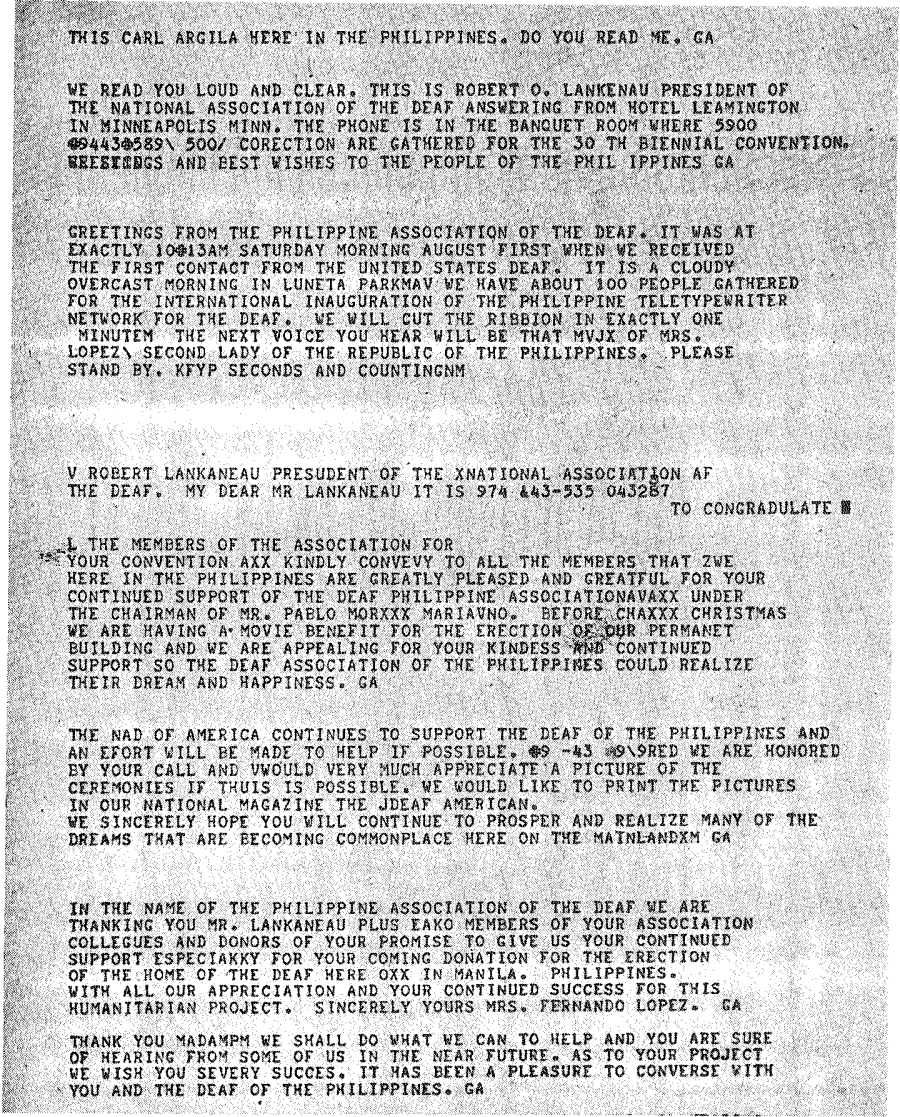
========================================
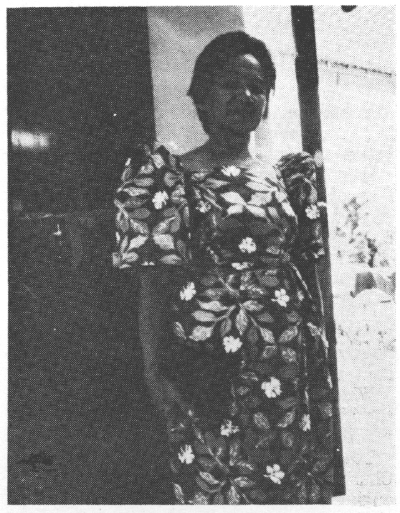
Mrs. Paula F. Guiterrez at the inauguration of the Philippine Teletypewriter Network. She is
wearing a native Filipino "butterfly" dress.
====================================
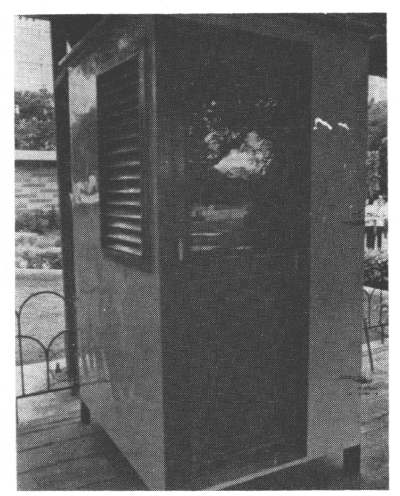
Booth housing the teletypewriter installation used in the inauguration of the Philippine network.
It is located at the coffee shop 1)1 the deal.
==========================================
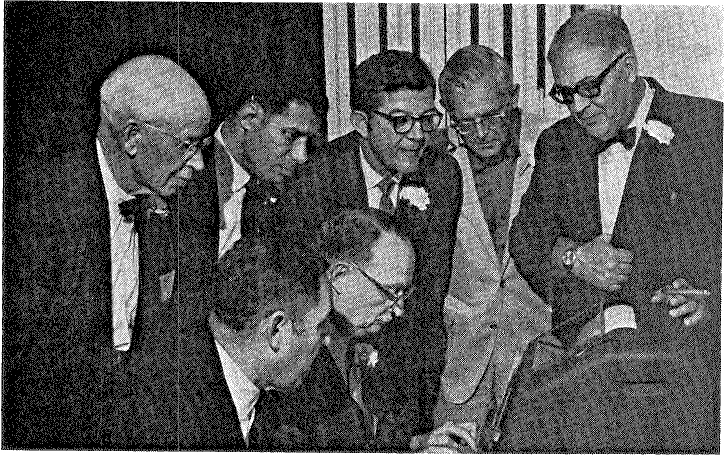
ONLOOKERS ALL-Gathered around President Robert O. Lankenau, who was at the Minneapolis end of a
teletypewriter linkup with the Philippines, were, standing left to right: Gordon L. Allen, Albert Pimentel, Frederick C. Schreiber, Edward Carney and Dr. Boyce R. Williams. Half-sealed and looking over
President Lankenau's shoulder is Jess M. Smith.
EDITOR'S NOTE - WE NEED A
CLEAN COPY OF THIS MAGAZINE ISSUE TO SCAN PHOTOS FROM A
BIT BETTER!
|





